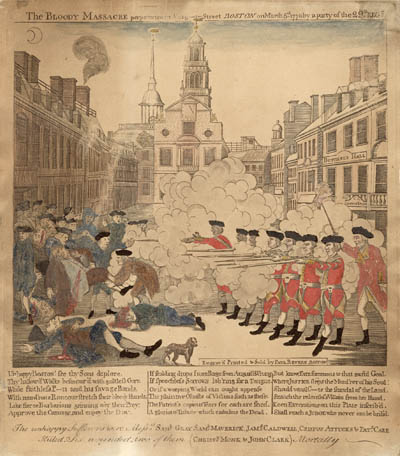
On the evening of 5 March 1770, soldiers occupying the town of Boston shot into a crowd, killing or fatally wounding five civilians.
The event was witnessed and described by many, in both words and images. Newspapers summarized the incident and, as the legal process got underway, depositions were collected and recorded. In the immediate aftermath of the shootings, both patriots and Tories realized the propaganda value of the event and began gathering depositions from witnesses to support their interpretations of what soon became known as the “Boston Massacre.”
 The Bloody Massacre perpetrated in King Street, Boston on March 5th 1770 by a party of the 29th Regiment
The Bloody Massacre perpetrated in King Street, Boston on March 5th 1770 by a party of the 29th Regiment
 The Fruits of Arbitrary Power: or The Bloody Massacre
The Fruits of Arbitrary Power: or The Bloody Massacre
At the same time, a contest among Boston engravers and printers to bring to the public a representation of “late horrid Massacre in King-Street” led to the publication of one of the most famous political prints in American history. Paul Revere’s The Bloody Massacre Perpetrated in King Street was advertised for sale on March 26, 1770. Revere’s success, however, was at the expense of Henry Pelham, a Boston painter and engraver, who wrote to him on March 29, complaining bitterly about how Revere had dishonorably copied Pelham’s “plate of the late Murder” without his permission, depriving him of any profit from his print, “as truly as if you [Revere] had plundered me on the highway.” An advertisement for Pelham’s print, The Fruits of Arbitrary Power, or the Bloody Massacre, first appeared in Boston newspapers on April 2, 1770.

The Massachusetts Historical Society holds seven engravings of the same scene, interpreted and reinterpreted by several creators, as well as a painting of the event from 30 years later.
Explore the differences between these representations side by side with the Perspectives on the Boston Massacre Comparison tool.
“...the Blood of our Fellow Citizens...” “...greatly enraged...”
“...Caution and Secrecy...” “...embarrassed with troops...”
“...Reports of killed and wounded...” “The noise of the Bells...”
“...this Dark day...” “...a Scheme of misinterpretation...”
Representation of the Boston Massacre was as varied in written accounts as it was in visual interpretations. From firsthand accounts in diary entries to newspaper articles to courtroom testimonies, everyone seemed to have a different idea of what actually happened and who was to blame.
Read a series of quotes from a wide variety of sources through the Perspectives on the Boston Massacre site.